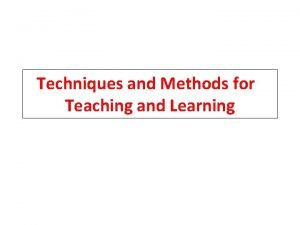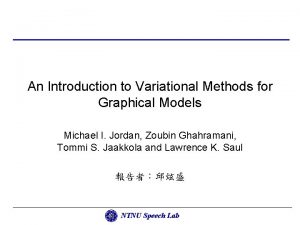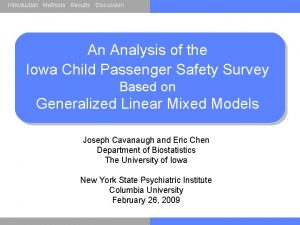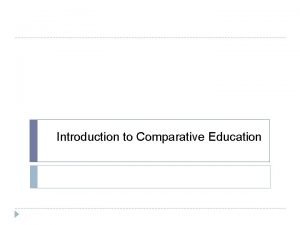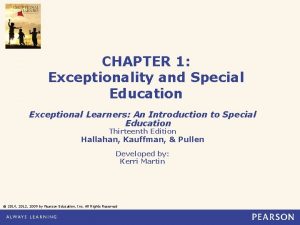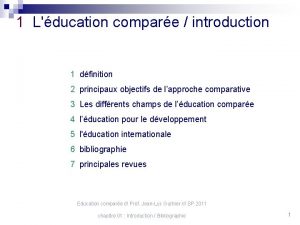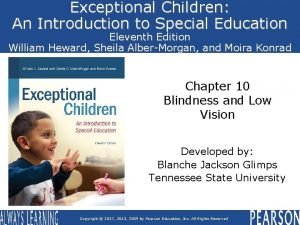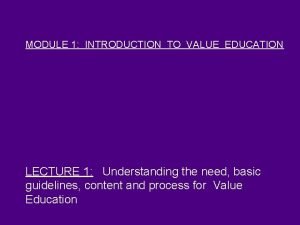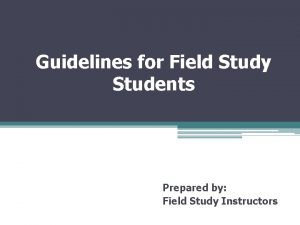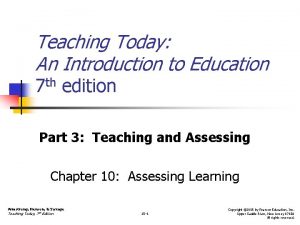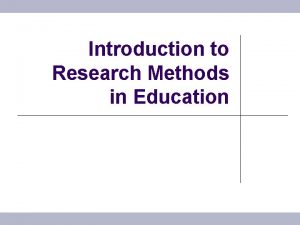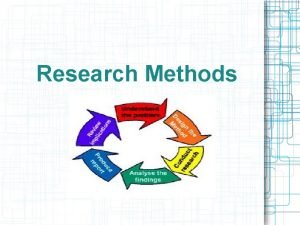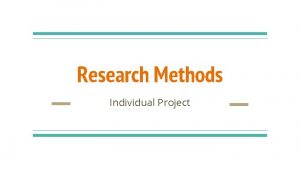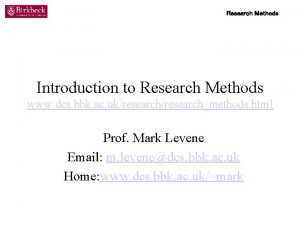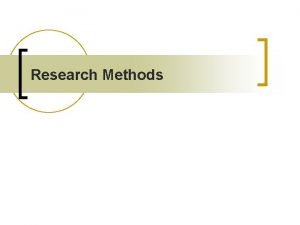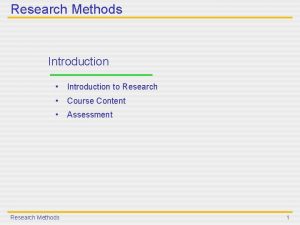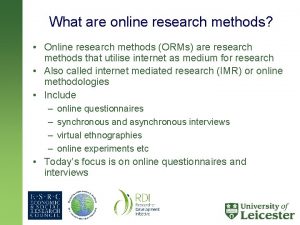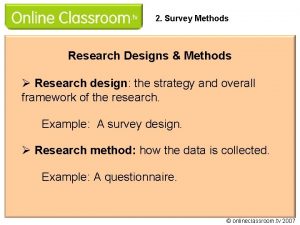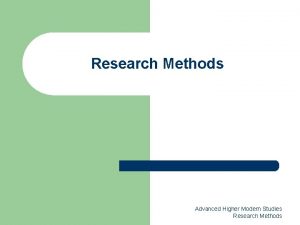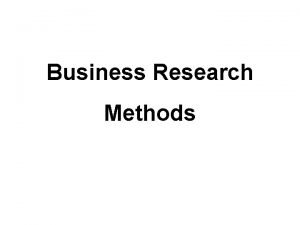Introduction to Research Methods in Education Research Methods



![… [a child] was brought back for me to test, and I was putting … [a child] was brought back for me to test, and I was putting](https://slidetodoc.com/presentation_image_h2/10f82ad4f1ae084c6d2a69ecd53ef256/image-4.jpg)

















- Slides: 21

Introduction to Research Methods in Education

Research Methods l l l Why is it important to understand research methods for interdisciplinary researchers? Types of research How do you measure learning experimentally? l l l Within subjects design Between subjects design What are you measuring? Important Statistical terms [other methods]

Research methods as boundary object in interdisciplinary research l Study of cross-disciplinary research collaboration (Mercier, Penuel, Remold, Villalba, Kuhl & Romo, under review) l The Bilingual Baby Project l l 4 -year longitudinal study Neuroscience, cognitive science, sociology How does growing up in a bilingual environment influence cognitive development & school readiness? Biggest issues was sample selection (methods)
![a child was brought back for me to test and I was putting … [a child] was brought back for me to test, and I was putting](https://slidetodoc.com/presentation_image_h2/10f82ad4f1ae084c6d2a69ecd53ef256/image-4.jpg)
… [a child] was brought back for me to test, and I was putting [an ERP] cap on and then his mom said, well, he’s used to this from going to the neurologist … and then she told me that he has epilepsy. And I thought to myself, well, okay, I’m wasting the next two-hours because I’m not going to be able to use the data…. . A quantitative researcher would never include a child that—you wouldn’t even waste the time and resources.

It’s difficult because you do form close relationships with the families…. So it was then much harder for our group to eliminate them from the pool, which we didn’t. We have followed up, we’ve gone and interviewed her, and it would be very interesting to see what kind of school readiness skills that child has and what kind of problems that mother has encountered. I know that they wanted children who had no other disabilities in order to focus on their language acquisition, but not all children are of this type

Two Types of Research l Quantitative l l l Qualitative l l Experimental Surveys (usually) Biography, phenomenology, grounded theory, ethnography & case study Mixed methods l l You can’t account for context with numbers The plural of anecdote is not data

What do you want your data & results to look like? l l Do you want to show learning, engagement, the process of the activity? Do you want to show that your tool works, or that it is better than an alternative? Do you want to describe, code, run statistics, present a case study? How will you design the study to get the type of results you want to present?

How do you measure learning experimentally? Ecology lesson - Aim: to teach 5 year olds about complex systems - Ten 1 -hour long sessions over 5 weeks - “Embodied curriculum” - Technology; dancing; CLAIM: Embodied curriculum is a drawing good way to teach complex systems No way to know whether it was the curriculum, or just being taught that led to learning

How do you measure learning experimentally? (and know that it’s because of what you did…) Pre/post test design (within subjects) l l l Sequestered problem solving (SPS) Preparation for future learning (PFL) Free-write/free recall Delayed post-test Multiple baseline/single case design

How do you measure learning experimentally? (and know that it’s because of what you did…) Control design (between subjects) l l l Only some of the participants receive intervention & compare post-test scores between control & experimental groups Compare ‘experimental group’ with previous groups who did not receive intervention Randomized control trials (the medical model)

2 x 2 design Godden & Baddeley (1975) Recall Condition On Land Under water Learning condition On Land 20 20 Under Water 20 20

But what are you measuring? Prerequisites for Maths Course - Is maths 101 necessary to pass stats 202? - Half of students had taken maths 101 - All students take stats 202 CLAIM: No need to take - Contrast outcomes maths 101 before taking stats 202 Floor effect: either the post-test didn’t measure the content or very little was learned from stats 202.

But what are you measuring… l Is it valid? l l l Is it reliable? l l l Internal validity (is the effect caused by the IV) External validity (would it replication beyond the sample) test-retest reliability Split-test reliability [piloting]

What sort of learning will you measure?

Important statistical ideas l Independent variables l l l Dependent variables l l l The thing you manipulate/control for Main effects & Interaction effects between IV The outcome measure Floor effects & ceiling effects Statistical significance l l Usually <. 05 for social science Indicates whether the effect is genuine or due to chance

Important statistical ideas l Level of measurement l l Population & sample l l Normal distribution Descriptive statistics l l Nominal Ordinal Interval (& ranking) Means, standard deviations, standard errors, Parametric and non-parametric statistics

Assumptions for parametric statistics l l l Level of measurement must be at least interval Sample is drawn from a normally distributed population Homogeneity of Variance l l Variance of two samples is not significantly different Independence of scores

Questions?

Key things to look for: l Are the differences between conditions significant: l l l T-tests, ANOVA, Chi Square Is there a relationship between variables? l Correlations (note: you can’t tell causation from this) l Pay attention to r values (between 1 and -1). Which of the IVs cause the DV? l Regression Analysis (note: need very large sample size; controversial technique)

Survey design l In the past 24 hours, did you watch more than an hour of television programming, or not? Yes/No l In the past 24 hours, did you read a daily newspaper, or not? Yes/No On a scale of 1 to 7, please rate How satisfied were you with what you learned and the usability of the software? (1) Agree strongly……. (7) disagree strongly l

Survey design (things to remember) l l l Is there only one question in each item? Pilot with a number of people – do they read the question the way it was intended? Are all your scales in the same direction (if not, reverse them before analysis) Do the answers match the questions? How will you make sense of the answers l l What sort of analysis can you do on rating, frequency, open -ended items? Are particular answers ‘socially desirable? ’
 Wax pattern fabrication pdf
Wax pattern fabrication pdf Peek model for readiness to learn
Peek model for readiness to learn Introduction of electrochemistry
Introduction of electrochemistry An introduction to variational methods for graphical models
An introduction to variational methods for graphical models Introduction method result and discussion
Introduction method result and discussion Introduction to chemistry section 3 scientific methods
Introduction to chemistry section 3 scientific methods How formal education differs from als
How formal education differs from als Differences between health education and health promotion
Differences between health education and health promotion Extension education is non formal education
Extension education is non formal education Introduction of western education in india
Introduction of western education in india What are the defects of present curriculum
What are the defects of present curriculum Introduction of comparative education
Introduction of comparative education Exceptional learners: an introduction to special education
Exceptional learners: an introduction to special education Pédagogie comparée définition
Pédagogie comparée définition Introduction to history of education
Introduction to history of education Exceptional children an introduction to special education
Exceptional children an introduction to special education Physical education introduction
Physical education introduction Basic guidelines for value education
Basic guidelines for value education Field study portfolio
Field study portfolio Health education introduction
Health education introduction Teaching today an introduction to education
Teaching today an introduction to education Exceptional children an introduction to special education
Exceptional children an introduction to special education

